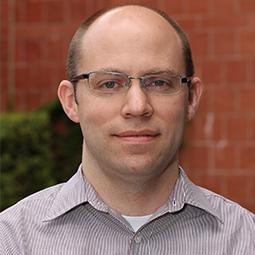An Emphasis on Team Science Draws a Brain Tumor Researcher to Become an SC CTSI Scholar
Neuro-oncologist Nathan Robison knew that a lot of valuable research was not benefitting pediatric populations. The SC CTSI Workforce Development training is helping him reach across disciplines and departments to improve clinical studies and apply discoveries more quickly and efficiently.
In 2013, when Nathan Robison, MD, joined the Keck School of Medicine of USC as assistant professor of clinical pediatrics, and became an attending physician at Children's Hospital Los Angeles, he brought along fairly extensive training and background in his main research interests: pediatrics and brain tumors.
But that training sparked a realization for Robison: how much potentially relevant research into new drugs or other therapies was focused on adult populations, but not pediatric.
"I was mostly thinking about new and better ways to conduct clinical research with kids," said Robison. "I saw that a lot of talented researchers were doing novel work, but the research is not necessarily benefitting patients who are children."
Prior to signing on at Keck and CHLA, Robison completed a residency and fellowship at Children's Hospital Los Angeles, and then an additional fellowship in Pediatric Neuro-Oncology at Dana Farber/Children's Hospital Cancer Center in Boston. It provided a broad view of the research being conducted in the field Robison wanted to concentrate on--a category of brain tumors that sometimes occur in people who have a common genetic condition called Neurofibromatosis Type 1 (NF1).
Getting scientists out of their silos.
But it was that gap between adult and pediatric research that fueled Robison's decision to apply for additional training as a Clinical and Translational Research (CTR) Scholar through the Southern California Clinical and Translational Science Institute (SC CTSI). The curriculum ranges from scientific skills such as study design, statistics and grant writing, to non-technical but still important parts of the professional life of principal investigators, including skills like finding research funding or managing a lab.
SC CTSI fellows work on personal research projects under the guidance of educators in the workforce development team. Robison's research focused on a category of NF1-related tumors called optic pathway glioma (OPG.) In NF1 children, OPG tumors, however, are unpredictable and doctors disagree about evaluation procedures.
In his research, Robison sought to describe the natural history of OPG to determine at what age it is visible with MRIs, and when symptoms appear. And, in fact, his research challenged conventional wisdom about OPG tumors in NF1 kids.
But it was the SC CTSI program's strong emphasis on the growing importance of team science and cross-disciplinary research that was especially important for Robison. It was becoming increasing clear to Robison that the biggest gains for patients with NF1 brain tumors would require coordinated effort with scientists working outside the specialty of pediatric brain tumor research.
"To do this, I needed to know how to reach out to other researchers, and how to design different kinds of trials, so the conversation could be more intelligent in how we apply the science to benefit the greatest number of people," said Robison.
Drug development is one area that can be leveraged more effectively, explained Robison. "We're dependent on the folks in the lab coming up with new drugs and approaches that can be applied in clinical research, but it's not always someone in brain tumor research who investigates the drugs," he said. "Sometimes they're doing work in a completely different area but their research is still very relevant for us."
For example, Robison recalled that discoveries made by a team in the Department of Urology that was studying cell mechanisms in adult cancers could be applicable for treatment of a rare, still-incurable brain tumor in children.
Making science more strategic.
But long term, beyond any one particular treatment or procedure, Robison wants to contribute to the already-expanding conversation between research areas. This not only enables more strategic design of trials and studies to make them more valuable scientifically, but also extends the professional reach and connections of the specific researchers.
"We have to think out of the box and use team science if we're going to take advantage of all the science that's out there," he said. "Being better at team science is one of the most important skills I started to develop in the SC CTSI training."
For more about Robison's research, watch this video of his poster presentation.




